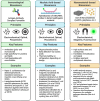Strategic Detection of Escherichia coli in the Poultry Industry: Food Safety Challenges, One Health Approaches, and Advances in Biosensor Technologies
- PMID: 40710069
- PMCID: PMC12293759
- DOI: 10.3390/bios15070419
Strategic Detection of Escherichia coli in the Poultry Industry: Food Safety Challenges, One Health Approaches, and Advances in Biosensor Technologies
Abstract
Escherichia coli (E. coli) remains a major concern in poultry production due to its ability to incite foodborne illness and public health crisis, zoonotic potential, and the increasing prevalence of antibiotic-resistant strains. The contamination of poultry products with pathogenic E. coli, including avian pathogenic E. coli (APEC) and Shiga toxin-producing E. coli (STEC), presents risks at multiple stages of the poultry production cycle. The stages affected by E. coli range from, but are not limited to, the hatcheries to grow-out operations, slaughterhouses, and retail markets. While traditional detection methods such as culture-based assays and polymerase chain reaction (PCR) are well-established for E. coli detection in the food supply chain, their time, cost, and high infrastructure demands limit their suitability for rapid and field-based surveillance-hindering the ability for effective cessation and handling of outbreaks. Biosensors have emerged as powerful diagnostic tools that offer rapid, sensitive, and cost-effective alternatives for E. coli detection across various stages of poultry development and processing where detection is needed. This review examines current biosensor technologies designed to detect bacterial biomarkers, toxins, antibiotic resistance genes, and host immune response indicators for E. coli. Emphasis is placed on field-deployable and point-of-care (POC) platforms capable of integrating into poultry production environments. In addition to enhancing early pathogen detection, biosensors support antimicrobial resistance monitoring, facilitate integration into Hazard Analysis Critical Control Points (HACCP) systems, and align with the One Health framework by improving both animal and public health outcomes. Their strategic implementation in slaughterhouse quality control and marketplace testing can significantly reduce contamination risk and strengthen traceability in the poultry value chain. As biosensor technology continues to evolve, its application in E. coli surveillance is poised to play a transformative role in sustainable poultry production and global food safety.
Keywords: Escherichia coli; One Health; antimicrobial resistance; avian pathogenic E. coli; biosensors; foodborne pathogens; point-of-care testing; poultry diagnostics.
Conflict of interest statement
The authors declare no conflict of interest.
Figures



Similar articles
-
Prevalence of specific serogroups, antibiotic resistance and virulence factors of avian pathogenic Escherichia coli (APEC) isolated from clinical cases: A systematic review and meta-analysis.Microb Pathog. 2024 Sep;194:106843. doi: 10.1016/j.micpath.2024.106843. Epub 2024 Aug 6. Microb Pathog. 2024. PMID: 39117015
-
Commensal Escherichia coli inhibits the growth and modulates the fitness, virulence, and antimicrobial resistance of Salmonella Heidelberg in vitro.Microbiol Spectr. 2025 Aug 18:e0333624. doi: 10.1128/spectrum.03336-24. Online ahead of print. Microbiol Spectr. 2025. PMID: 40823798
-
Prevalence and antimicrobial resistance of Salmonella and pathogenic E. coli in broiler farms, Wakiso district, Uganda.PLoS One. 2025 Jul 1;20(7):e0309599. doi: 10.1371/journal.pone.0309599. eCollection 2025. PLoS One. 2025. PMID: 40591571 Free PMC article.
-
Antimicrobial resistance and virulence gene profiles of Escherichia coli isolated from poultry farms using One Health perspective in Abeokuta, Nigeria.BMC Microbiol. 2025 Jul 16;25(1):440. doi: 10.1186/s12866-025-04135-9. BMC Microbiol. 2025. PMID: 40670940 Free PMC article.
-
Management of urinary stones by experts in stone disease (ESD 2025).Arch Ital Urol Androl. 2025 Jun 30;97(2):14085. doi: 10.4081/aiua.2025.14085. Epub 2025 Jun 30. Arch Ital Urol Androl. 2025. PMID: 40583613 Review.
References
-
- U.S. Food & Drug Administration (FDA) E. coli and Foodborne Illness: Information for the Public, FDA Actions, and Recommendations. [(accessed on 2 June 2025)];2020 Available online: https://www.fda.gov/news-events/public-health-focus/e-coli-and-foodborne....
-
- World Health Organization (WHO) E. coli, Factsheet. 2018. [(accessed on 2 June 2025)]. Available online: https://www.who.int/news-room/fact-sheets/detail/e-coli.
-
- Hasso-Agopsowicz M., Lopman B.A., Lanata C.F., McQuade E.T.R., Kang G., Prudden H.J., Khalil I., Platts-Mills J.A., Kotloff K., Jit M. World Health Organization Expert Working Group: Recommendations for assessing morbidity associated with enteric pathogens. Vaccine. 2021;39:7521–7525. doi: 10.1016/j.vaccine.2021.11.033. - DOI - PubMed
Publication types
MeSH terms
LinkOut - more resources
Full Text Sources
Medical
Research Materials

